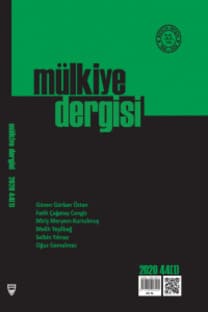Bir bellek mekanı olarak televizyon: Bu kalp seni unutur mu?
Television as a space for memory: How does my heart ever forget you?
___
- Agamben, Giorgio (2010). Tanık ve Arşiv: Auschwitz'den Artakalanlar, çev. Ali İhsan Başgül, Ankara: Dipnot Yayınları.
- Anderson, Steve (2001). "History, TV and Popular Memory", Edgerton, G. R. ve P. C. Rollins (der.). Television Histories: Shaping Collective Memory in the Media Age, USA: University Pres of Kentucky içinde, s.19-36.
- Baker, Ulus (2010). Kanaatlerden İmajlara: Duygular Sosyolojisine Doğru, İstanbul: Birikim Yayınları.
- Barthes, Roland (2000). Camera Lucida: Fotoğraf Üzerine Düşünceler (3. Baskı), çev. Reha Akçakaya İstanbul: Altıkırkbeş Yayınları.
- Doane, Mary A. (2001). "Information, Crises, Catastrophy" Landy, M. (der.) The Historical Film: History and Memory in Media, New Brunswick: Rutgers UP içinde, s.269-285.
- Doğruöz, Hakan Ş. (2007). "Sinemada 12 Eylül: Bellek Yitimine Direnmek ve Temsil Stratejileri", Birikim. S.222, Ekim, s.68-80.
- Düzel, Neşe (2003). "Üç Yılını Cehennemde Geçirdi", http://www.radikal.com.tr/Radikal.aspx?aType= RadikalHaberDetay&ArticleID=673856, (Erişim tarihi: 11.07.2010).
- Edgerton, Gary R. (2001). "Introduction", Television Histories: Shaping Collective Memory in the Media Age, Edgerton, Gary R. ve Peter C. Rollins (der.). USA: University Pres of Kentucky içinde, s.1-18.
- Esen, Şükran (2000). 80'ler Türkiyesi'nde Sinema (2.Baskı), İstanbul: Beta Yayınları.
- Göle, Münir (2007). "Doğru Olmadığını Biliyorum Ama Öyle Hatırlıyorum" Cogito, S.50, İstanbul: Yapı Kredi Yayınları, s.23-30.
- Heath, Stephen (1990). "Representing Television" Logics of Television, Mellencamp, P. (der.). Bloomington: Indiana University Press içinde, s.267-302.
- Holdsworth, Amy (2008). Cinema Journal, CA1, S.3, Spring, s.137-144.
- Hron, Madelaine (2008). "Torture Goes Pop!" Peace Review: A Journal of Social Justice, 20, s.22-30, DOI: 10.1080/10402650701873684, (Erişim tarihi: 10.08.2010).
- Huyssen, Andreas (1999). Alacakaranlık Anıları: Bellek Yitimi Kültüründe Zamanı Belirlemek, çev. Kemal Atakay, İstanbul. Metis.
- Huyssen, Andreas (2003). Presents Pasts: Urban Palimpsests and the Politics of Memory, Stanford University Press.
- İnsan Hakları Derneği Diyarbakır Şubesi (1991). Kamber Ateş Nasılsın? Hapishanelerden Öyküler, İstanbul: Belge Yayınları.
- Longford, Barry (1999). "You Cannot Look at This: Thresholds of Unrepresentability in Holocaust Film", The Journal of Holocaust Education, C. 8, S. 3, Winter, s.23-40.
- Maktav, Hilmi (2000). "Türk Sinemasında 12 Eylül", Birikim, S.138, Ekim. s.79-84.
- Nalçaoğlu, Halil (2009). "'Arşivselliğin' Kapanışı: Toplumsal Hafıza ve Arşiv Olarak İnternet", Osmanlı Bankası Arşiv ve Araştırma Merkezi, http://www.obarsiv.com/pdf/halil_nalcaoglu.pdf. (Erişim tarihi: 20.07. 2010).
- Nora, Pierre (2006). Hafıza Mekânları, çev. Mehmet Emin Özcan, Ankara: Dost.
- Özcan, Nazan, "Hikaye Anlatmayı Seven Adam", http://www.radikal.com.tr/ek_haber. php?P.k=r2&haberno=529L (Erişim tarihi: 17.8.2010).
- Özgüç, Agah (2005). Türlerle Türk Sineması, İstanbul: Dünya Kitapları.
- Özkök, Ertuğrul, "Biz ne sesi ile uyanmıştık", http://hurarsiv.hurrivet.com.tr/goster/haber. e^r.?id=351673&vazarid=10. (Erişim tarihi: 05.08.2010).
- Robben, Antonius C. G. M. (2005). "How Traumatized Societes Remember: The Aftermath of Argentina's Dirty War", Cultural Critique. S.59, Winter, s. 120-164.
- Sancar, Mithat (2007). "Geçmişle Yüzleşme: Bir Adalet ve Özgürleşme Sorunu", Geçmişin Yükünden Toplumsal Barış ve Demokrasiye Uluslararası Geçmişle Hesaplaşma Konferansı (24-25 Şubat), İstanbul Bilgi Üniversitesi Dolapdere Kampüsü, http://old.boell-tr.org/images/cust_files/080311151508. jjdf (Erişim tarihi: 12.07.2010).
- Sancar, Mithat (2008). Geçmişle Hesaplaşma: Unutma Kültüründen Hatırlama Kültürüne, İstanbul: İletişim.
- ISSN: 1305-9971
- Yayın Aralığı: 4
- Başlangıç: 1965
- Yayıncı: Mülkiyeliler Birliği Genel Merkezi
Bölgesel kalkınmada sosyal boyut: Yazında varolan durum ve öneriler
Medya Endüstrisi Üzerine Yapılan Çalışmalarda Siyaset, Kuram ve Yöntem
İspanya Örneği Üzerinden "Karşılaştırmalı Medya Sistemleri"
Bir bellek mekanı olarak televizyon: Bu kalp seni unutur mu?
Avrupa Birliği ile uyum süreci bağlamında Türkiye'de yeni yayıncılık yasası
1980 Sonrası Değişen Medya Ortamında Gazeteci: Zanaatkar Mı, Profesyonel Mi?
